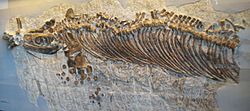Cymbospondylus facts for kids
Quick facts for kids CymbospondylusTemporal range: Middle – Upper Triassic
|
|
|---|---|
 |
|
| Cymbospondylus fossil | |
| Scientific classification | |
| Kingdom: | |
| Phylum: | |
| Class: | |
| Subclass: | |
| Superorder: | |
| Order: | |
Cymbospondylus was a large but primitive Triassic ichthyosaur of the Middle and Upper Triassic. It had a long eel-like body up to 10 meters or more in length.
Cymbospondylus is known from both Germany and Nevada. No doubt, like other large marine reptiles and present-day aquatic mammals, it had a wide oceanic distribution.
Palaeobiology
Cymbospondylus was one of the largest ichthyosaurs. Fossils ranging from 6 to 10 metres (20 to 33 ft) long. It was also one of the least fish-like of the ichthyosaurs, lacking a dorsal fin and fluked tail. It did, however, have an elongated snout like other ichthyosaurs.
The one metre long head of Cymbospondylus, with large jaws, contained rows of teeth adapted for catching and holding on to fish, belemnites, and cephalopods such as ammonites. The long tail would have been excellent for swimming, and allowed Cymbospondylus to move at fast speeds and efficiently hunt down shoals of swimming fish.
Adult Cymbospondylus probably spent much of their time hunting in deep offshore water, only coming into shallow water to breed or to catch seasonally available prey. Like other ichthyosaurs, Cymbospondylus probably gave birth to live young, as it had no way to lay eggs. These, on reaching adult size, probably had few, if any, predators that could harm them.
The eel-like tail of Cymbospondylus made up almost half the total body length, and it is possible that the tail was used as a primary swimming mechanism. Like present day sea snakes, Cymbospondylus probably swam by wriggling its body from side to side.
Images for kids
See also
 In Spanish: Cymbospondylus para niños
In Spanish: Cymbospondylus para niños




